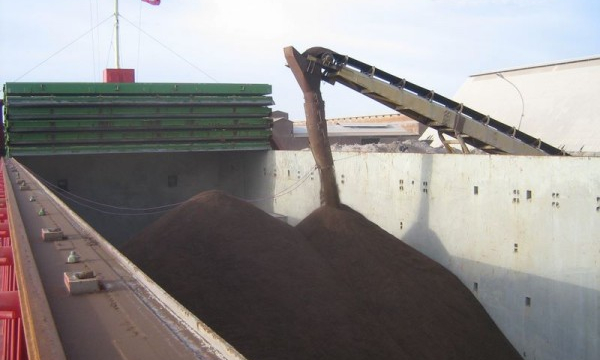Transportation of olive cake
Biomass products, and in particular olive cake, may be transported in several different ways. In the most of the cases olive cake and olive cake pellets is delivered by several types of transport (truck+ vessel, or just truck or truck+ rail). At this case, it is important to choose suitable vehicle combinations for the material to be transported, since olive cake is considered as material that requires careful treatment and may provoke a spontaneous combustion. The vehicles such as truck, train and sea vessel must be adapted to load a flammable material. The three basic cause of spontaneous combustion are high temperature, high moisture content and lack of ventilation.
Very important is to monitor the temperature of the olive cake not only during its storage but also during the loading. The favorable travel temperature for olive cake is around 5 - 25°C. In tropical ports, temperatures of 40 - 60°C may occur in the products to be loaded. Actually in Seville in August the surface of olive cake pile temperature reaches 65 degrees and probably higher. The temperature of surface does not define the temperature of the whole product, since inside temperature could be much different. But it is not excluded that inside the pile the temperature can be also rather high
Because of that the presence of control inspection during the loading is important, inspectors should monitor the temperature inside the pile, usually it is measured with thermometer with high steel pipe that could be deeply introduced into the material and thermometer is put inside the pipe deeply into the material.
For cooling down the material it has to be turned around by bulldozers and let to lay on the pier before loading on board of the vessel. During the loading process the temperature decreases some grades, but it could be not enough, it should be paid an attention to it before the loading to prevent any drastic consequences. Temperature over 60 degrees C have to be regarded as too high for loading.
The main risk for transport of any cargo which has heated ashore is that the product is loaded at temperatures of above 55°C and retains this temperature in the hold and, due to the poor thermal conductivity of the product, areas with a permanent heat build-up form for the entire duration of transport. The longer the duration of transport, the greater are the consequences of heating.
The poor thermal conductivity of pressing residues is also of significance to self-heating. Self-heating may occur simultaneously at various points within the cargo and continue to such an extent that carbonisation occurs. The resultant fine-pored carbon has the characteristic of starting to smoulder when exposed to oxygen.
The poor thermal conductivity also explains late detection of the seat of a fire. The particular risk is that the cargo burns within the heap without generating appreciable quantities of smoke. The seat of the fire carves out a cavity with the result that fatal accidents may occur when someone steps onto the surface of the cargo and breaks through into such cavities.
In order to be able to detect a cargo fire in good time, it is recommended to make regular gas measurements of the hold air. A rapidly rising CO2 content indicates increased microbial activity combined with evolution of heat within the cargo.
This evolution of heat ultimately leads to the spontaneous combustion of the cargo, with evolution of carbon monoxide (CO). The presence of CO gas is considered the most reliable indication of a fire. Levels of 0.002 - 0.005 vol.% of CO in the air are deemed normal, with values rising to above 1 vol.% in a cargo fire.
It is possible to conclude from characteristics observable in the ship's hold, such as temperatures, appearance and odour of the cargo, whether the product was loaded at too high temperature and whether it has undergone self-heating with microbial spoilage and subsequent autoxidation.
Pursuant to the IMDG Code/IMO 4, ships must be equipped with systems for injecting CO2 (carbon dioxide) or any inert gas.It is forbidden to damp the fire with water as it will only increase the fire.
Once we had a situation, actually in Seville, when olive cake pile was laying during all summer on pier, it was very hot weather, so the pile temperature of course increased a lot. When the pile begun to move by bulldozers, the vessel has arrived, so there was no sufficient time to reduce the pile temperature. Finally, the vessel was loaded with hot olive cake. Apparently there were no signs of flames, but once the product begun discharging in the destination port , it was exposed to the oxygen, and begun to burn. In the country where it was discharging , the decision was made to put the burning product to the barges and send it back to the sea, away from the pier. As you can imagine in this moment the barges begun to burn as well, we have no pictures of that but it was the perfect scenario to make war movie about the sinking ships. So, the temperature of the product is very important.
As it was mentioned before it is also important to protect olive cake from all forms of moisture (seawater, rain and condensation water), since moisture encourages mould, mustiness and creates a high risk of self-heating. At the first glance it may seem strange how moisture can cause fire. The reason of self-combustion because of the high moisture content it is as follows: when moisture begins to evaporate, the steam moves fat particles causing combustion. It can be compared with the matches that light up when scratched. Despite of that fat content is below 4 percent it could be enough to provoke a fire.
Also ventilation is important in transportation of olive cake. As with bulk cargoes of expeller, olive cake is also often not ventilated. In order to avoid moisture damage on the surface of the cargo, ventilation must not be performed with cold external air. Also it should be avoided for loading a wet parts of the product. A certificate stating residual oil content, water content should be demanded from the consignor. If the oxidation processes under way in the hold are vigorous, it is not possible to dissipate the quantity of heat generated by ventilation. This particularly applies if a sub-batch susceptible to oxidation with a low water content is loaded next to a sub-batch with a high moisture content. All this should be represented in Material Safety Data Sheet that issue consignee and that should be signed by consignor and by the master of the vessel.
To sum up if you see the white smoke that looks like as during the election of Pope in Rome, that is how combustion of olive cake begins, try to prevent access of oxygen. Move the product by bulldozers or in a case it is already dropped into the vessels holds, the captain should inject inert gas.







